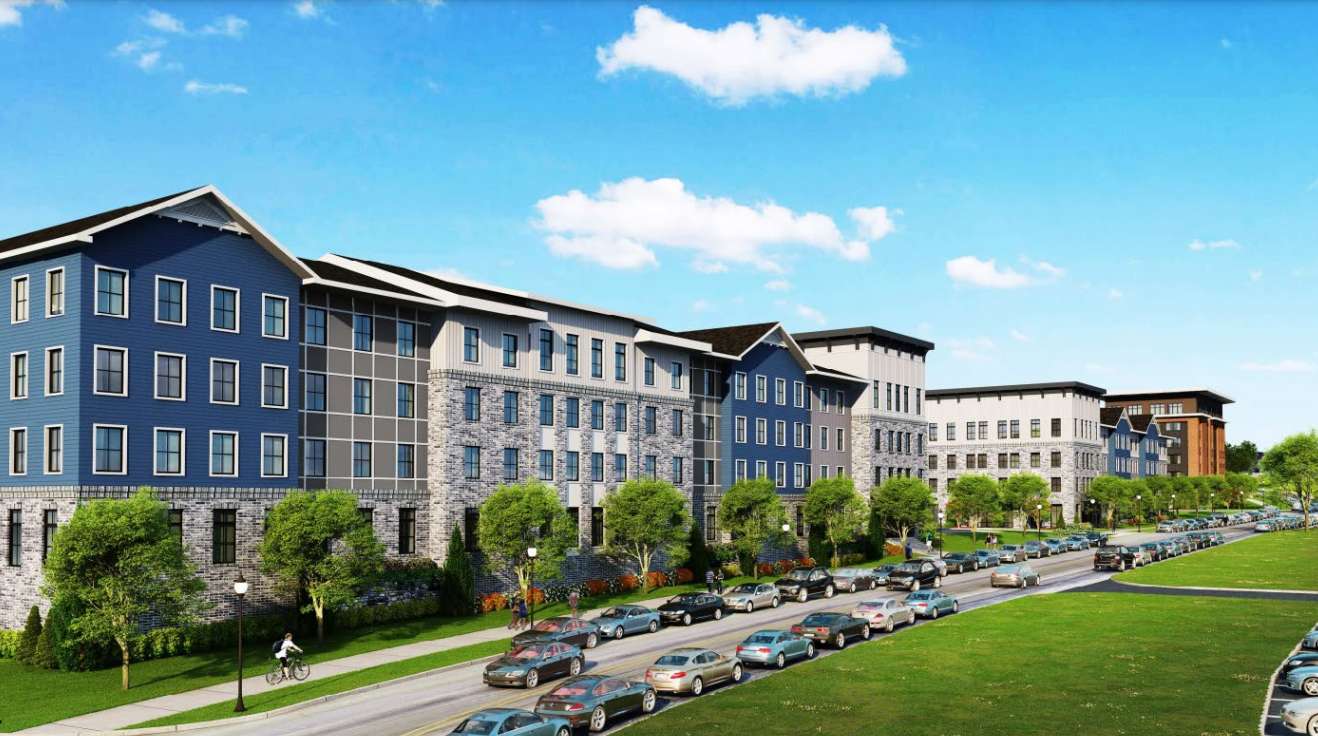
Fairfax County is moving steadily towards its target of building 10,000 net new affordable housing units by 2034.
The county has roughly 4,000 units built, planned or under construction that count towards the goal set in 2022, Department of Housing and Community Development (HCD) Deputy Director of Real Estate Development and Finance Anna Shapiro told the Fairfax County Board of Supervisors at a housing committee meeting on Tuesday (Feb. 27).
So far, 879 new units aimed at households earning 60% of the area median income (AMI) and below have been built since 2020.
“These are serving on kind of lower end of the income spectrum, but all the way down to 30% in a lot of cases as well,” Shapiro said. “And as you can see there’s a mix of multifamily and senior housing that we’ve delivered.”
An additional 986 units are under construction in projects like One University and Ilda’s Overlook in the Braddock District, which are set to wrap up in the summer. The county has roughly 1,100 units in its development pipeline, and another 950 units are in the planning phase.
The county is also working to encourage the development of more for-sale workforce dwelling units (WDUs). A task force submitted recommendations to the board’s housing committee in November.
The task force recommended shifting the program’s target range from up to 120% of the AMI down to 70 to 100% AMI, extending the geographic availability of for-sale WDUs and improving the mix of housing to allow for more family-sized units.
Additionally, the county wants to explore ways to preserve the existing stock of affordable housing, such as the Coralain Gardens Apartments in West Falls Church. A survey on market affordability is set to begin in the summer.
A plan amendment that would address the affordability of manufactured housing (the county’s term for mobile homes) is set to go before the Fairfax County Planning Commission sometime in October, followed by board review before the end of the year.
Board Chairman Jeff McKay said he was pleased with the county’s progress thus far but asked for a more detailed breakdown by magisterial district.
“One of the things that certainly makes me happy when looking at this is that we’re building affordable housing in every corner of the county and not just in the same concentrated areas that we did for decades,” McKay said.
Shapiro noted that the numbers are fluid, particularly since the county must consider the entire life cycle of proposed projects.
“Every project has ups and downs,” she said.
Braddock District Supervisor James Walkinshaw also sought clarifications on whether the county has maxed out its potential for affordable housing projects on county-owned land.
“My sense is, probably across the county, we’ve taken advantage of the easier opportunities and the larger parcels, but maybe that’s not the case,” Walkinshaw said.
Springfield District Supervisor Pat Herrity asked for more information on homeownership for affordable housing units. The county is in the midst of hiring a homeownership director, according to HCD Director Tom Fleetwood.
“It solves a number of generational wealth problems,” Fleetwood said.
Rendering via Fairfax County
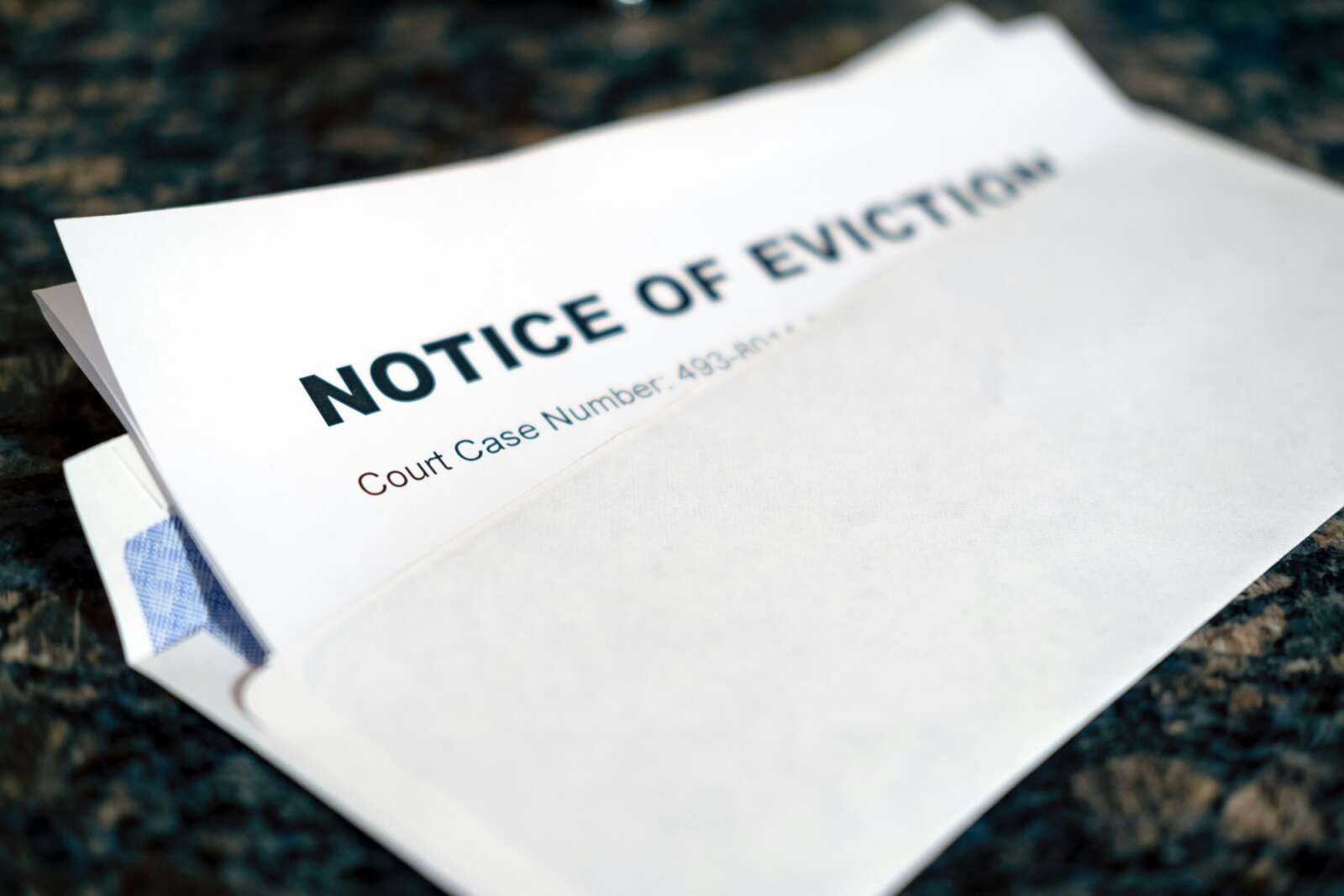
Eviction cases continue to rise in Fairfax County as the millions of dollars in financial and legal support allocated during the pandemic run out, county staff say.
Without the nationwide eviction moratorium that ended in August 2021 and federal relief funds, the county’s eviction numbers could have been much higher during the pandemic, staff told the Fairfax County Board of Supervisors at a housing committee meeting on Tuesday (Feb. 27).
However, residents are still struggling due to high housing costs and other challenges like inflation, stagnant wages and a lack of access to higher paying jobs, according to Aimee Garcia, access and economic mobility division director for Neighborhood and Community Services (NCS).
“We still are seeing rent be one of the largest needs across the community,” she said. “We are still seeing needs in regards to shelter, health, housing search…job search…inquiries around Medicaid, subsidized housing and dental.”
Last year, the number of eviction lawsuits (unlawful detainers), legal eviction notices (writs of eviction), and completed evictions were three times higher than in 2021, according to the county’s Eviction Data Dashboard.
In 2023, Fairfax County recorded a total of 7,618 unlawful detainers, 2,961 writs of eviction, and 963 evictions. Some of the most affected zip codes include Hybla Valley and Groveton (22306), Huntington (22303), Lincolnia (22312), McLean west of I-495 (22102), Herndon (20171), Annandale (22003), Bailey’s Crossroads (22041), and Lorton (22074).

Since the start of the pandemic, the federal government has provided billions of dollars in aid to assist community members with housing, food and other needs through the CARES Act and American Rescue Plan Act (ARPA).
Unlike most Virginia localities that used a state-managed online portal to distribute federal funding, Fairfax County chose to distribute rental assistance directly to residents using its internal social services agency, Coordinated Services Planning (CSP).
The agency initially faced challenges with a high volume of requests and slow processing times. In some cases, individuals waiting for rental and utility assistance through CSP experienced months-long delays.
However, over the past year, CSP Program Manager Luis Rey says the county has expanded access to legal aid, housing resources and rental assistance.
Now, in addition to calling a phone number, renters can submit applications online to CSP to determine their eligibility for rental aid — an option initially limited to landlords. The agency also introduced an estimated wait time and callback feature for applicants.
“They can leave the phone number and they’ll be called back to connect for an assessment,” Rey said.
Additionally, CSP works with the nonprofit Legal Services of Northern Virginia, the courts and Fairfax County Sheriff’s Office to help residents understand their options during the eviction process, Rey says.
Those efforts have helped mitigate the pandemic’s impact, according to Garcia. However, she noted that call volumes are still higher than they were pre-pandemic.
“We do continue to see new cases on a monthly basis at levels that are indicative of the continued need throughout the community,” she said.
To date, the county has distributed $150 million in rental assistance since the pandemic hit in 2020, according to county officials.
The county is still using ARPA funds for eviction prevention and rent assistance, but Deputy County Executive Chris Leonard warns the funds are dwindling, and more local funding may be needed starting next year.
“We’re going to utilize additional ARPA for FY 25,” he told the supervisors, referring to the fiscal year that will start on July 1. “…That will obviously be able to help us support the need, but it will also help us continue to monitor and figure out where we’re going to land with regards to what our need is out there for future rent assistance from the county and from our community partners.”
Photo via Allan Vega on Unsplash
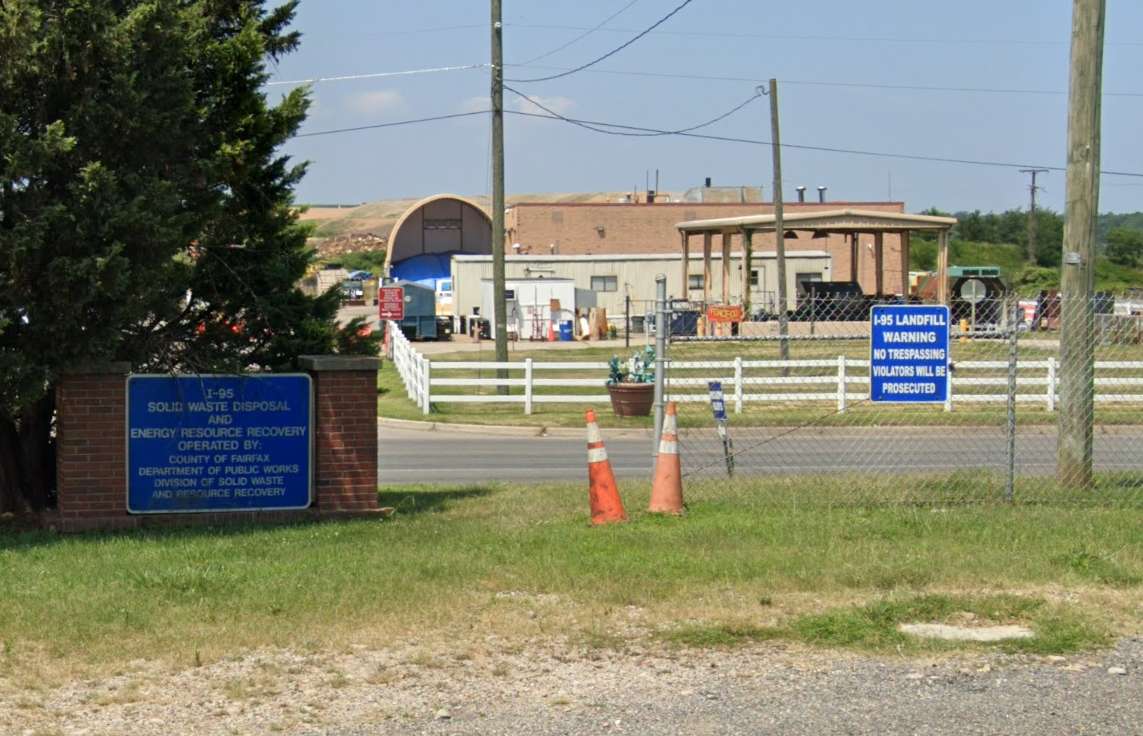
(Updated at 5:05 p.m. on 2/29/2024) Fairfax County’s supervisors believe that grassland birds deserve a safe nesting ground, even if it’s atop a former landfill.
The Board of Supervisors directed county staff on Feb. 20 to work with the Virginia Department of Environmental Quality (DEQ) and the Audubon Society of Northern Virginia to identify areas within the I-95 Landfill Complex (9850 Furnace Road) in Lorton where mowing can be minimized to protect grassland birds during their nesting season.
Though the facility still provides waste disposal services, most of the landfill closed around the late 1980s to early 1990s, according to Mount Vernon District Supervisor Dan Storck’s office.
Since then, the site has become a habitat for 100 species of grassland birds, including grasshopper sparrows, eastern meadowlarks, bobolinks and American kestrels.
“These are all birds of concern because of declining grassland habitats,” Greg Butcher, the former director of bird conservation for the Audubon Society of Northern Virginia, told FFXnow in an email.
The Fairfax County Department of Public Works and Environmental Services (DPWES) currently has an agreement with the Audubon Society to permit bird monitoring at the landfill.
Recently, the environmental organization reached out to the board, urging the county to consider restrictions on mowing during the nesting season, from April 1 to mid-July, due to its potential to destroy nests and eggs and harm fledglings and adult birds.
However, since federal and state regulations require mowing for post-closure maintenance of the landfill, DPWES and the Audubon Society must collaborate with DEQ to devise a strategy that both preserves nesting birds and ensures access to the landfill cover and gas wells, while also maintaining proper drainage.
Representatives from DPWES and the Audubon Society are set to start discussions soon and aim to formulate a plan in the upcoming weeks, DPWES Deputy Director Eric Forbes told FFXnow in an email.
“We are anticipating about a month for the development and coordination of the pilot plan to try to be ready for this season’s bird nesting,” he said. “The pilot plan would include a map showing no mow areas, access pathways to our landfill infrastructure (gas wells and stormwater conveyance), and a schedule for mowing in non-peak nesting season.”
For its part, the Audubon Society plans to send volunteers to map the locations of the birds and their potential nesting areas, Butcher says. But he noted the organization doesn’t know yet how big the “no-mow” area will need to be.
It’s also unclear how much the project will cost, but the board asked staff to provide an estimate in a report.
The county’s future plans for the now-closed parts of the I-95 landfill include a solar panel array and a potential indoor skiing facility from the Tysons-based company Alpine-X.
In addition, a public park with trails, an amphitheater and other amenities is being developed on the former Lorton Landfill across the street at 10001 Furnace Road. Owned by Furnace Associates, Inc., the private landfill stopped accepting construction and demolition debris in 2018 and completed the closure process in 2021.
Correction: This story originally conflated the I-95 Landfill Complex with the privately owned Lorton Landfill. It has been updated to clarify that the two sites are different. Image via Google Maps
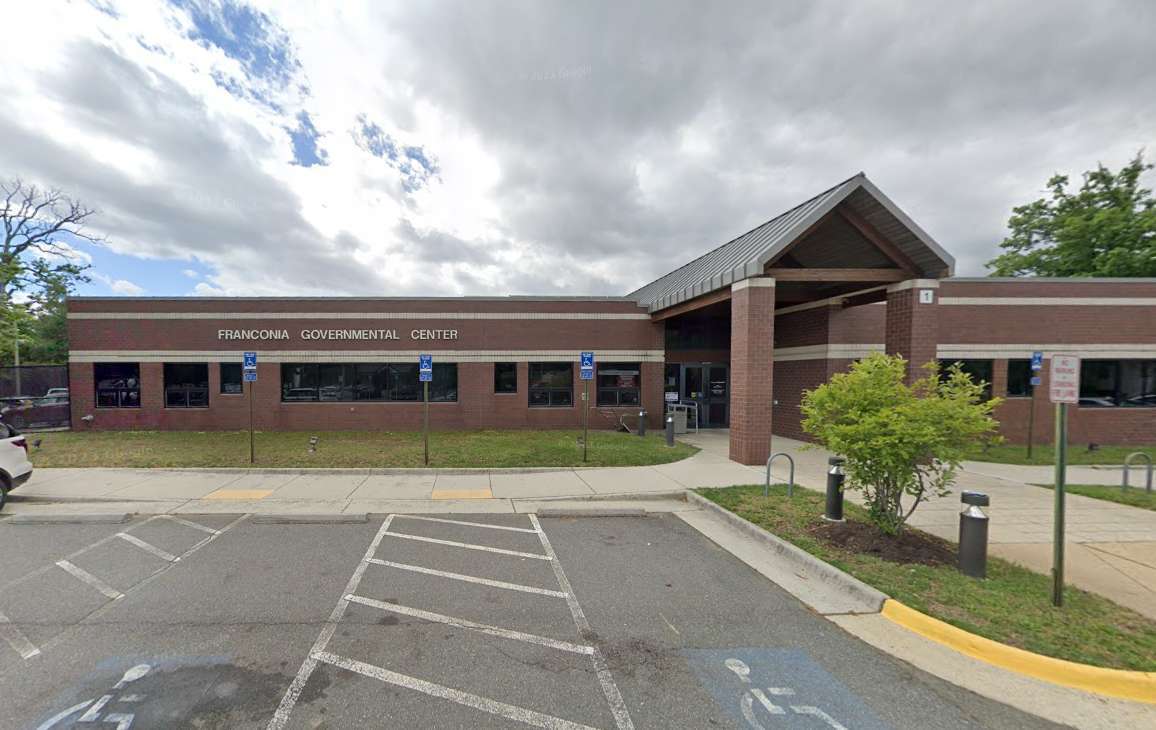
A plan to redevelop the site of the Franconia Governmental Center has been delayed again.
At Fairfax County Board of Supervisors meeting on Feb. 20, Franconia District Supervisor Rodney Lusk formally deferred a decision to convey a nearly 3-acre property at 6121 Franconia Road to the Fairfax County Redevelopment and Housing Authority to May 21.
Following a three-hour public hearing on Jan. 23, Lusk said it was apparent that more community discussions were needed ahead of the decision.
“Given the interest in this property and the need to ensure that our entire community has an opportunity to voice their opinions on the property transfer, I believe more time is required before this matter returns to the Board,” Lusk said.
The deferral was approved with no discussion.
Lusk plans to begin several community conversations in April with the Department of Housing and Community Development and the Department of Neighborhood and Community Services.
“This dialogue will allow residents and stakeholders the opportunity to express their ideas and vision and in a subsequent meeting receive feedback on development processes and concepts,” he said. “These in-person community conversations, along with an online engagement platform option, are expected to increase public understanding of affordable housing and general public knowledge to inform decision-making.”
NFP Affordable Housing Corp., Good Shepherd Housing and SCG Development Partners hope to develop the site into up to 120 units of affordable housing, including 25 units for qualified police, fire, teachers and medical personnel.
The development would include one- to three-bedroom units targeting individuals and families with incomes between 30 to 80% of the area median income, according to a proposal submitted by the development team. At the time the proposal was submitted, the team aimed to begin construction in January 2027, fully leasing the units by September of that year.
The Franconia Governmental Center is in the process of being relocated. Construction on a new facility that will be combined with the Kingstowne Regional Library began in 2022, and it’s expected to be ready for occupancy in early 2025, according to the project page.
Image via Google Maps
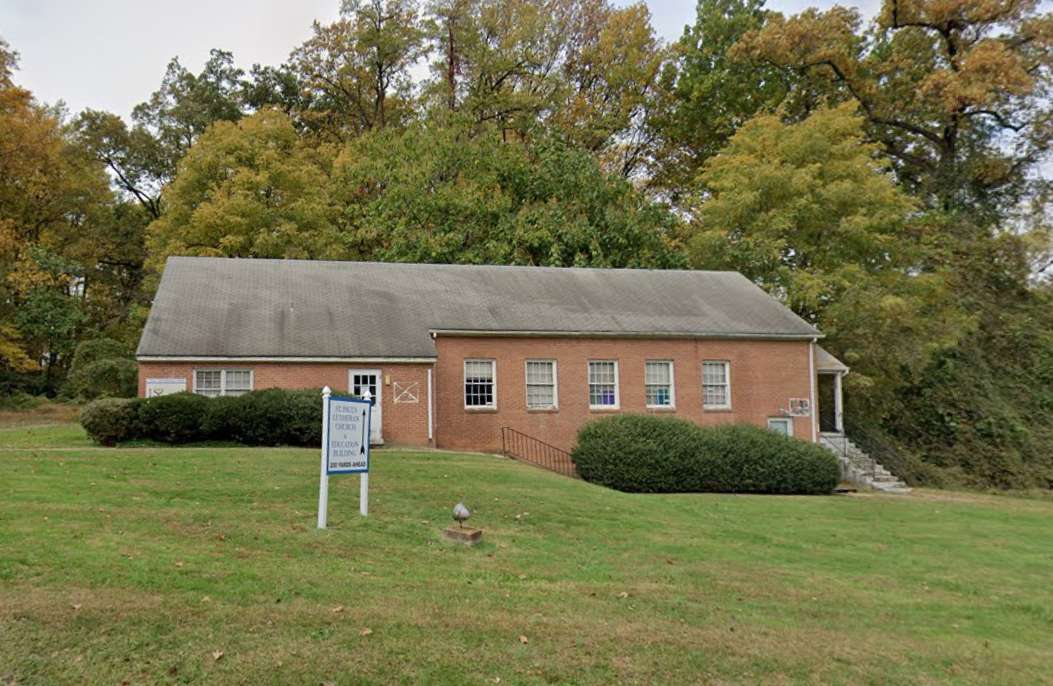
Plans to build housing in front of St. Paul’s Lutheran Church in Idylwood have been resurrected.
After a previous attempt in 2019 sputtered out, the church has found a new developer partner to potentially buy vacant portions of its property at 7426 Idylwood Road and transform it with residential development.
The developer EYA submitted an initial pitch to Fairfax County last summer for approximately 65 to 75 townhouses that would be constructed on two parcels of the roughly 10.7-acre site, an EYA marketing manager told FFXnow. The church intends to stay and use the money from the land sale to fund an expansion of its building, which was built in 1968, per county records.
“EYA is interested in the site for townhome development given its proximity to nearby established retail amenities, Tysons Corner and the City of Falls Church for work and shopping, and a direct bus connection to the West Falls Church Metro Station,” EYA said in a statement. “…We look forward to continuing to engage with the community, staff and elected officials as we develop our plan for this site.”
EYA’s proposal revives a development plan filed in March 2019 by Toll Mid-Atlantic LP Company, an affiliate of the Delaware-based home builder Toll Brothers.
According to that application, St. Paul’s wanted to sell part of its property to pay for a “family life center” that was approved in 2005 but never constructed “due to financial constraints.” The church consists of a main sanctuary with an attached educational building, though it also owns a separate, now-vacant building that once housed Lutheran Social Services.
Toll Mid-Atlantic sought to replace the empty building and another undeveloped parcel — totaling about 5.85 acres — with 67 residential units, which would’ve been a combination of single-family townhomes and two-over-two multi-family units.
The county’s land use database indicates that the application was scheduled for a public hearing before the Fairfax County Planning Commission multiple times, most recently on Sept. 30, 2020, but it ultimately got deferred indefinitely.
To allow for EYA’s development, the county needs to revise its comprehensive plan for the site, which currently designates the entire church property as a future residential development with 16-20 dwelling units per acre.
With the church committed to remaining at the site, the Fairfax County Board of Supervisors directed county staff on Tuesday (Feb. 20) to craft a plan amendment that would reduce the intensity of the housing envisioned for the site.
“Recognizing that the Church wishes to remain on site, and this impacts the available area for development and the design of the site, a Plan amendment for residential development at a lower density, with suitable conditions related to site design, recognizing retention of the existing Church, is appropriate,” Providence District Supervisor Dalia Palchik said when introducing the request.
Recalling the previous attempt to develop the site, she added that “transportation improvements and others are key to this development.”
The proposed amendment will be added to the second tier of the county’s comprehensive plan amendment work program, meaning it will be reviewed concurrently with rezoning and special permit amendment applications. Submitted on June 27, 2023, EYA’s proposal is still in the “pre-application” stage, so it’s unclear when an official plan will be available.
According to a summary report from the Department of Planning and Development, the initial concept tweaks Toll Mid-Atlantic’s earlier design to allow for more open space and tree preservation. It also features a recommended sidewalk along Idylwood Road and commits to replenishing landscaping that screens the church from existing townhouses to the south.
Image via Google Maps
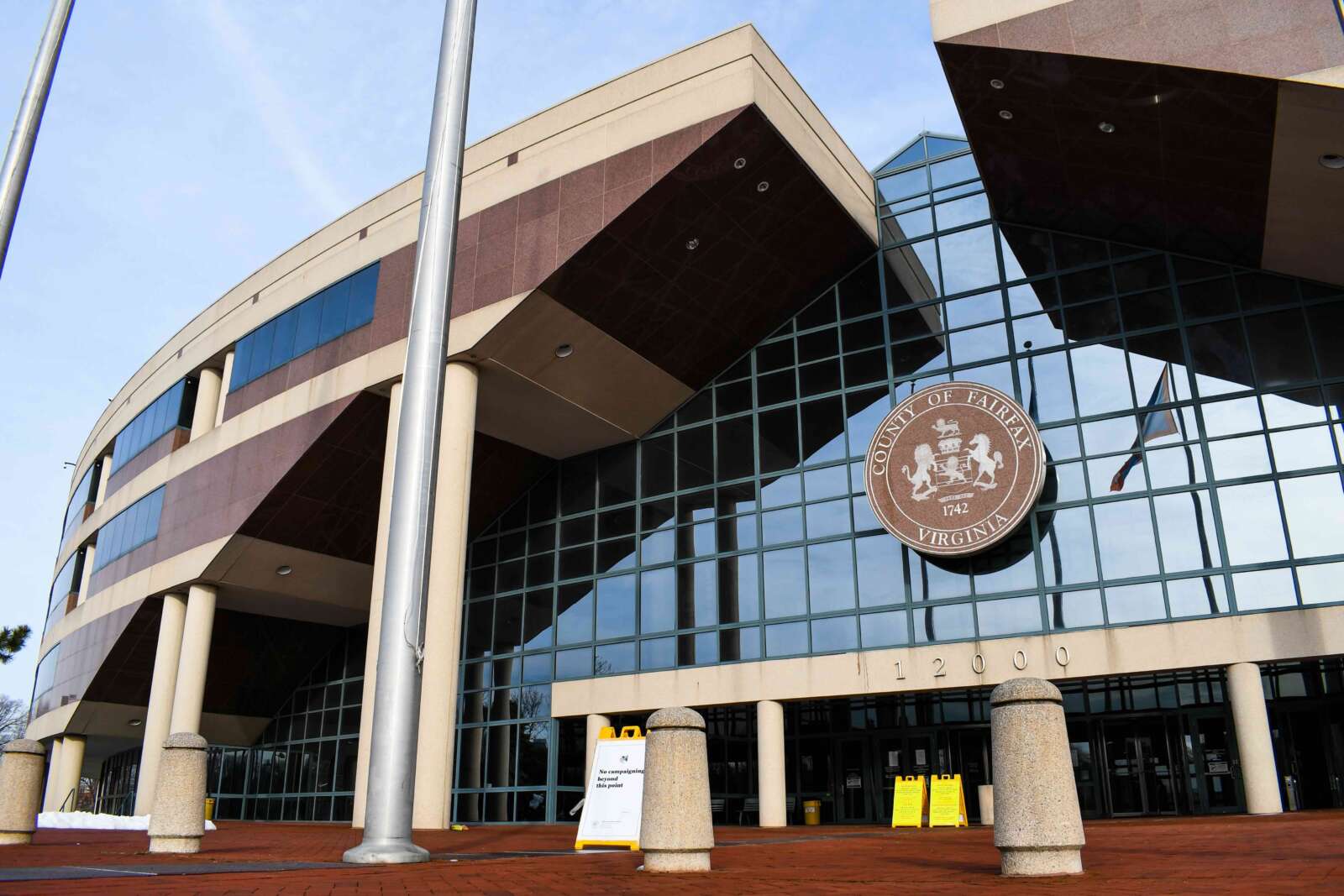
As anticipated, Fairfax County is looking at a tight budget for the coming year that will once again lean primarily on residential property owners to offset a declining commercial tax base.
County Executive Bryan Hill has proposed a 4-cent increase in the real estate tax rate, even as he presented an advertised fiscal year 2025 budget to the Fairfax County Board of Supervisors yesterday (Tuesday) that largely limits spending to obligations like public schools and employee compensation.
If adopted, this would be the county’s first real estate tax rate increase in six years, Hill said in a message to the board. Last year, Hill proposed a flat tax rate that the board ultimately reduced by 1.5 cents to $1.095 per $100 of assessed value, though property owners still saw their bills go up by $412, on average, due to rising home values.
The proposed tax rate of $1.135 per $100 for FY 2025, which starts on July 1, would raise the average tax bill by just over $524 and generate $129.28 million in revenue, according to the county.
“We are seeing some residential growth, but our commercial values have declined, resulting in an overall real estate growth of just over 2.7%,” Hill said. “Paired with significant expenditure pressures — particularly for employee pay and benefits, transportation requirements, and continued inflationary impacts — balancing this proposed budget has required difficult decisions.”
Home values up, commercial values down
Real estate tax revenue provides about 66% of the county’s general funds, which supports most county operations, from public safety agencies to libraries and parks. For FY 2025, more than three-quarters of that revenue (76.7%) will come from residential owners, who are facing an average assessment increase of 2.86% for 2024.
Though the number of home sales in the county last year declined, prices have continued to climb “due to low inventory,” Hill said. The average value of the county’s over 357,000 taxable residential properties for 2024 is $744,526, up from $723,825 in 2023.
By contrast, non-residential property values have dropped for the first time in three years by 1.24%, a dip mostly driven by a struggling office market. About 21.6 million square feet, or 17.2%, of the county’s 119.5 million square feet of office space is vacant — an uptick from last year’s rate of 16.7%, which was already a 10-year high.
With another 1 million square feet of office space under construction, mostly in Metro’s Silver Line corridor, the pressure to revitalize or replace under-utilized office buildings will likely only intensify going forward.
“That space is going to be snapped up quickly, which is going to create situations around our county that will be then vacant,” Hill said when asked by Franconia District Supervisor Rodney Lusk about possible remedies. “We have to figure out ways to fill those spaces, whether it is converting or doing something different on that plot of land. We have done a pretty good job in certain areas of revitalizing…but we need to do more.”
Schools and compensation dominate spending
With some growth projected from other sources, including an 8.8% increase in personal property taxes and a proposed 10-cent-per-pack increase in taxes on cigarettes, the county anticipates getting $363.22 million more in revenue than it did this budget year.
However, Hill says he proposed spending only on “adjustments which I feel are essential to maintain the quality workforce and dependable services upon which our residents rely.” Read More

The Fairfax County Department of Transportation is asking commuters for feedback on changes they would like to see along the Route 29 corridor.
The department recently launched a survey asking commuters how often they travel Route 29, the duration of their travel, and the mode of transportation they use.
The survey focuses on a 2.9-mile stretch of Route 29 near Fairfax City between Buckleys Gate Drive and Jermantown Road. The survey will help the county identify multi-modal solutions to support increased development in the area, according to Fairfax County Transportation Planning Section Chief Michael Garcia.
The county is seeking to shift away from the interchanges, road widenings and other auto-focused improvements currently recommended for the corridor.
“There have been development proposals in the corridor and trying to accommodate the Comprehensive Plan recommendations for interchanges may not be in harmony with how the area has developed and will continue to develop,” Garcia told FFXnow.
Instead, his team is working with Fairfax City and the Virginia Department of Transportation to study low-cost multi-modal solutions, such as bicycle and pedestrian upgrades, with the goal of preserving future mobility and accessibility in the corridor, as well as enhancing public spaces.
Garcia says the feedback collected from the survey will play a crucial role in shaping county staff’s recommendations for transportation improvements. Interested participants can fill out the survey online or leave a recorded message at 703-890-5898 (Project Code 3941) by Friday, March 1, 2024.
FCDOT will present the results at a virtual public meeting on Tuesday, March 12, at 7 p.m., per the study website.
Garcia noted that FCDOT’s study of this Route 29 section is “timely,” since the county is in the process of updating its plan for the Fairfax Center area, which spans about 5,500 acres between Centreville and Fairfax City bounded by Route 50 and 29.
As authorized by the Board of Supervisors last year, the county’s Department of Planning and Development is currently reevaluating its vision for the “core area” that includes Fair Oaks Mall and the Fairfax County Government Center.
Building on past reviews of the area-wide and low-density residential neighborhood goals, this third phase of the planning study will include a transportation analysis and consideration of additional housing on the Reserve at Fairfax Corner Apartments site. The property owner, Equity Residential, has requested more density at 11727 Fairfax Woods Way for a 405-unit residential building “to complement” the existing apartments.

Fairfax County is continuing talks on a proposal that could allow some residents to better access their homes in areas with certain traffic restrictions.
Cut-through mitigation restrictions prohibit turns into neighborhoods from major transit corridors during rush hour. While the restrictions aim to prevent local roads from getting jammed by drivers trying to evade traffic, it can make it challenging for residents to legally access their homes on those streets.
The Fairfax County Department of Transportation is proposing a residential cut-through permit zone that would exempt residents in affected neighborhoods from the restrictions by providing permits for their vehicle. Signs that restrict turns would be changed to say “resident permit required.”
After first proposing the permit program in early 2023, FCDOT presented an update to the Fairfax County Board of Supervisors at a transportation committee meeting on Tuesday (Feb. 15).
Currently, the county is considering introducing the program in three areas with existing cut-through restrictions.
- Carolyn Drive and Nicholson Street in Lake Barcroft
- Oxford Street and Downing Street in Annandale
- Thomas Avenue in Great Falls
“There are approximately 350 addresses that are impacted, and that could initially seek impairments if this program were implemented,” county transportation planner Henri Stein McCartney said.
Another seven communities are in the process of implementing cut-through restrictions.
“If all seven projects were implemented, we would expect to have approximately 1,300 addresses county-wide that could participate in the program,” McCartney said.
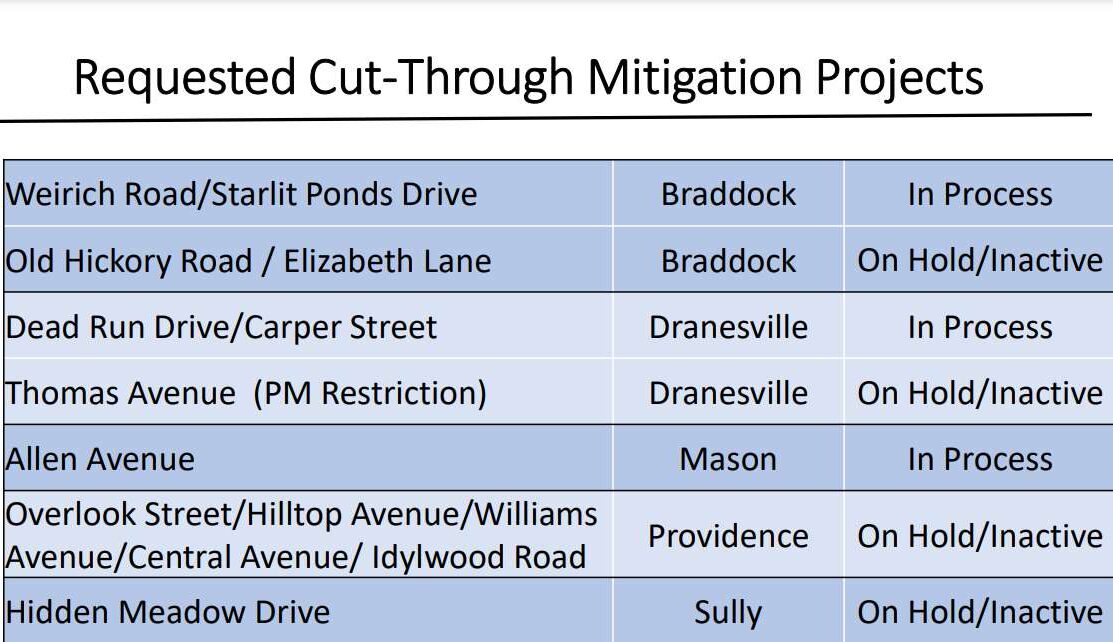
In January, the Board of Supervisors directed FCDOT to work with the Department of Tax Administration on revenue collection options for the program.
“In those conversations, tax administration recommended that we speak with the vendor that they currently have under contract for the county’s parking enforcement software,” McCartney said. “We are very early in our conversations with this vendor.”
FCDOT will return to the committee in June with additional information on using the vendor, she added.
The department is proposing a $25 permit fee for residents participating in the program. If the permits are implemented for all of the areas that have or are currently considering cut-through traffic restrictions, the county could collect an estimated $33,000 to $99,000 in gross revenue.
Chairman Jeff McKay questioned how the program would be enforced, saying it could put law enforcement in “awkward positions.”
“I don’t think we want our police checking every car that comes down the street during a certain period of time to verify residency,” he said. “I mean, to me…there’s a whole lot of problems with that.”
In its presentation, FCDOT noted that some neighboring jurisdictions, including Fairfax City, Vienna and Alexandria, have turn restrictions but don’t require permits for residents to legally access local roads. The only jurisdiction that does offer residents permits to get around turn restrictions is Falls Church City.
“Why did they decide to not offer permits and then how do they do enforcement? Because to me, that’s a really critical question here,” McKay said.
An officer with the Fairfax County Police Department conceded “it would probably be difficult to enforce,” adding that he couldn’t speak to what other localities are doing.
Hunter Mill District Supervisor Walter Alcorn asked county staff to look into automated enforcement as an option.
McCartney said she was unaware of any other jurisdictions currently using automated enforcement, but the vendor they’re working with offers it.
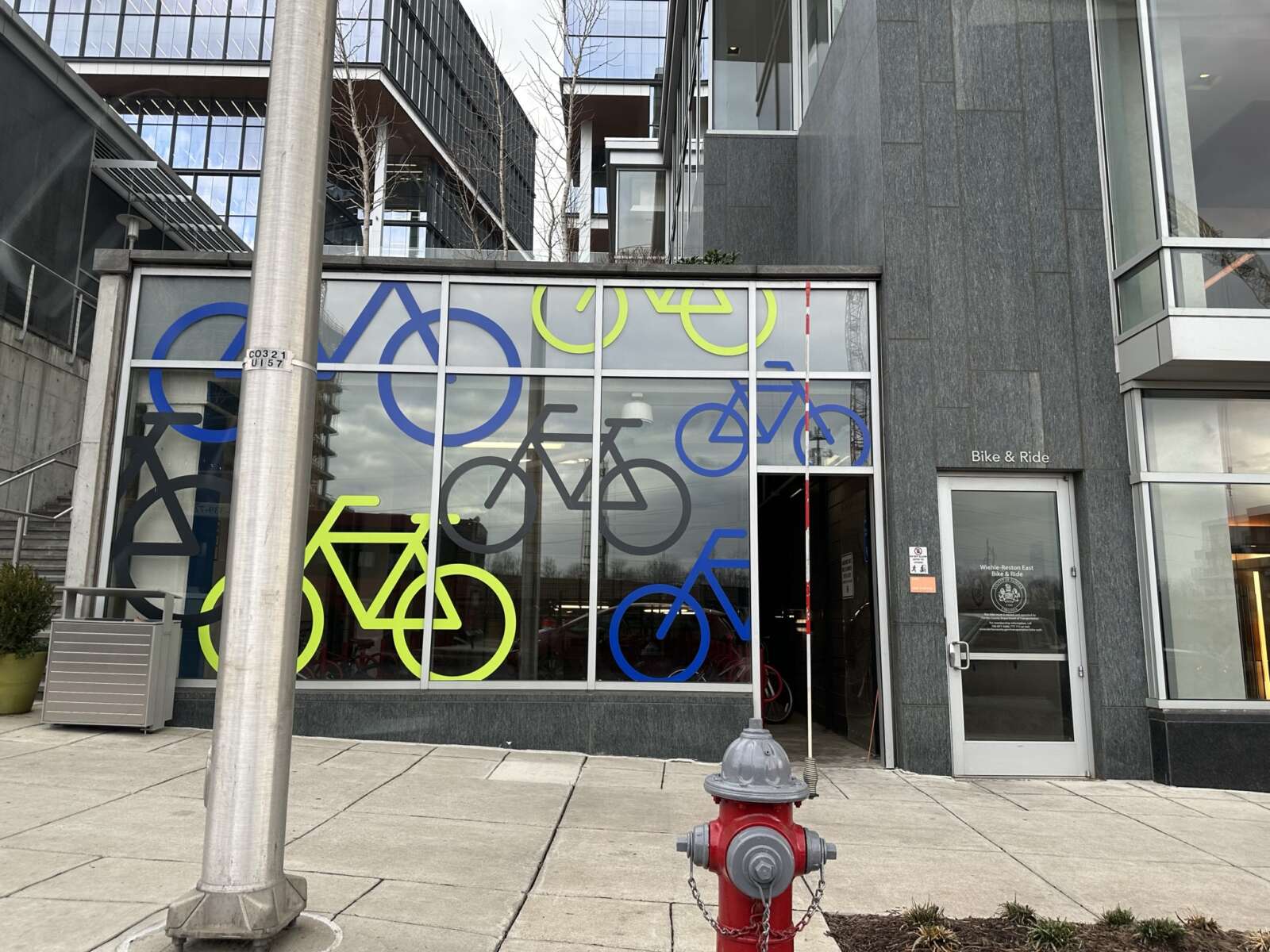
Fairfax County’s new bicycle parking standards are getting refined as part of a broad effort to ensure consistency across the county’s various transportation policies.
At a transportation committee meeting yesterday (Tuesday), the Fairfax County Board of Supervisors expressed support for an update to the bicycle parking guidelines — although the guidelines were not yet available for review.
The county got up to speed with the current age of telework and transit-oriented development by introducing bicycle parking requirements in September.
The “Parking Reimagined” initiative established how many bicycle parking spaces are required and basic rules for the design and general location of the spaces. But staff noted that the new requirements don’t align with guidelines formulated in 2014.
“It’s really great to know we’re thinking about this, that we’re tackling it. Doing this better will have great effects for the county,” said Dranesville District Supervisor Jimmy Bierman, who chairs the committee.
Additionally, the zoning ordinance doesn’t address parking ratios for visitor and long-term parking or provide detailed information about wayfinding signage, rack spacing, security needs and other amenities, county staff said in a presentation to the committee.
The guidelines currently being crafted would be divided by short-term parking for visitors and long-term parking, which is for employees, transit users, apartment residents and bicycle cages or lockers, according to Nicole Wynands, a planner for the Fairfax County Department of Transportation.
For short-term parking, the guidelines will cover location, access, markings, maintenace, rack types and spacing. Long-term parking guidance will detail similar issues, along with room layout, security recommendations, and e-charging.
Wynands noted that the guidelines will provide different ratios based on land use. FCDOT is contemplating a 90-10% split for long-term and short term parking, respectively, in residential areas and a the reverse split for long-term and short term parking respectively in retail areas.
“Retail use has a very different need,” Wyannds said.
Discussion on the proposal was limited, given that the details haven’t been officially reviewed by the board.
The county hopes to release the guidelines to the board soon so the public review process can begin in early March, followed by potential board endorsement by the summer.
Board of Supervisors Chairman Jeff McKay said that, although the guidelines were not yet available, he was supportive of the idea.
Hunter Mill District Supervisor Walter Alcorn said staff should ensure that existing bicycle guidelines for specific areas like Reston are consistent with other, similar policies.
“It seems like there needs to be some sort of normalizing across these different area guidelines,” Alcorn said.
McKay asked staff if there was some way to encourage more commercial residential properties to conform with the county’s guidelines on bicycle parking.
“I’m just wondering if we’re evaluating where we can see with our own vision today where the need for these facilities are,” he said.
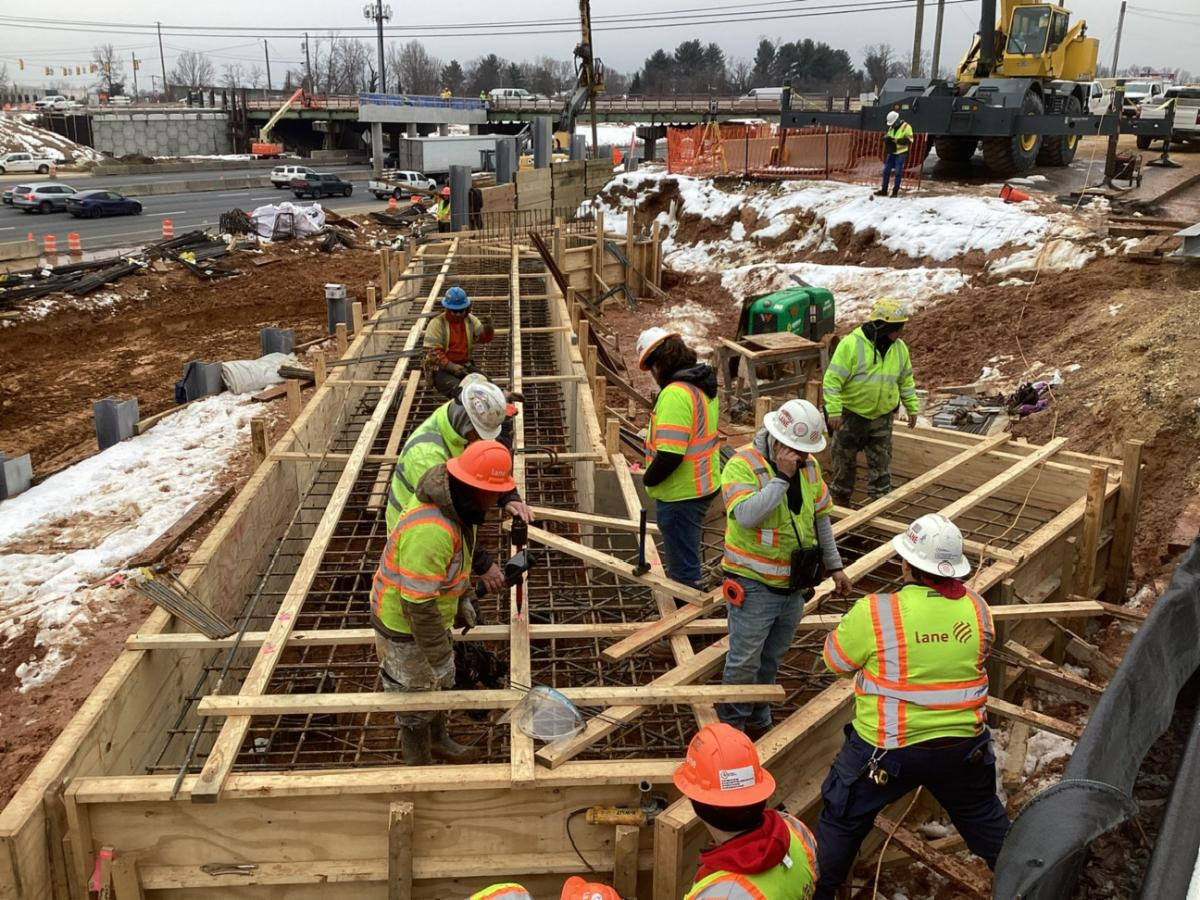
The Fairfax County Board of Supervisors wants answers now to its lingering questions about the Virginia Department of Transportation’s northern extension of the Capital Beltway (I-495) toll lanes.
County staff got the green light yesterday (Tuesday) to send a letter seeking clarity on VDOT’s coordination efforts with Maryland and plans to mitigate the environmental and traffic impacts of a construction project that has now been in progress for nearly two full years.
Dranesville District Supervisor Jimmy Bierman, who represents the McLean area most directly affected by the project, requested the letter for Virginia Transportation Secretary W. Sheppard Miller after a message that the board sent in September “inexplicably” went unanswered.
“I just think it’s absolutely ridiculous that we would send a letter to the Secretary of Transportation in September, and we’re sitting here in February and never got a response. It’s just absurd,” Bierman said at the transportation committee meeting, which he chaired.
Under construction since March 2022, the project known as 495 NEXT is adding 2.5 miles of express lanes on the Beltway from the Dulles Toll Road in Tysons past the George Washington Memorial Parkway in McLean.
VDOT has touted the widening as necessary to relieve congestion and add pedestrian, bicycle and transit connections in the corridor. Though they endorsed the project in April 2021, Fairfax County leaders — particularly Bierman’s predecessor as Dranesville District supervisor, John Foust — have warned that traffic relief will be limited without toll lanes on Maryland’s side of the Beltway.
VDOT estimates that the project would move more than twice as many additional people when coupled with Maryland toll lanes than it would as a standalone project.
After that analysis came out, however, Maryland downsized its plans to widen the Beltway and replace the aging American Legion Bridge in response to local opposition. The project stalled altogether last March when contracted toll lanes operator Transurban backed out.
Maryland officials began reviving the project last summer, proposing to widen the bridge and 6.5 miles of I-495 from the GW Parkway to I-270, Maryland Matters reported. A new design hasn’t been released, and construction isn’t expected to break ground until 2026 — a year after Virginia’s express lanes are scheduled to open.
In its September letter, the Fairfax County board urged VDOT to craft a written agreement with its Maryland counterpart to guide any work that may spill over into Virginia. Since Miller didn’t respond, there’s “prevailing uncertainty” over the local implications of Maryland’s project, according to the new draft letter. Read More

